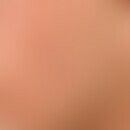Synonym(s)
DefinitionThis section has been translated automatically.
An autosomal dominant form of diffuse non-epidermolytic nonsyndromic palmoplantar keratoderma, Bothnian-type palmoplantar keratoderma, is caused by mutations in the AQP5 gene, which encodes the cell membrane water channel protein aquaporin 5, resulting in impaired epidermal water barrier function in the epidermis of the palms and soles. Autosomal dominant diffuse non-epidermolytic palmoplantar keratosis is characterized by the affected areas taking on a white, spongy appearance upon contact with water.
EtiopathogenesisThis section has been translated automatically.
Missense mutations in the AQP5 gene encoding the water channel protein aquaporin-5(AQP5). Protein structure analysis shows that these AQP5 variants have the potential to affect normal channel regulation. Immunofluorescence data show the presence of AQP5 at the plasma membrane in the stratum granulosum of both normal and affected palmar/plantar epidermis, suggesting that the altered AQP5 proteins are transported in a normal manner (Blaydon DC et al. 2013).
You might also be interested in
ClinicThis section has been translated automatically.
Mild diffuse, non-epidermolytic, non-transgressive palmoplantar keratosis with marked hyperhidrosis, the particular striking feature of which is the whitish swelling of the palms (and soles) after relatively short contact with water (washerwoman's hands). A typical feature is the almost complete disappearance of the manifestations within a few minutes or hours after drying of the hands.
A very characteristic feature of the disease is a tendency to maceration of the skin. Patients are prone to recurrent fungal infections with malodour due to bacterial superinfection (Krøigård AB et al. 2016).
Differential diagnosisThis section has been translated automatically.
Aquagenic diffuse non-epidermolytic palmoplantar keratosis must be distinguished from aquagenic palmoplantar keratosis (aquagenic acrokeratoderm), which is associated with a mutation in the CFTR gene, which codes for the "Cystic Fibrosis Transmembrane Conductance Regulator".
Aquasensitive palmoplantar keratosis with ichthyosis (see below Peeling skin disease D/E) also shows the clinical phenomenon of the so-called washerwoman's hands.
Note(s)This section has been translated automatically.
The historical name "Bothnian" refers to "the Bothnian Sea", the southern part of the Gulf of Bothnia, which lies between Sweden and Finland. In the bordering provinces a prevalence of this PKK type of 0.3 to 0.55% is observed.
LiteratureThis section has been translated automatically.
- Abdul-Wahab A et al. (2016) Autosomal dominant diffuse nonepidermolytic palmoplantar keratoderma due to a recurrent mutation in aquaporin-5. Br J Dermatol 174:430-432.
- Blaydon DC et al (2013) Mutations in AQP5, encoding a water-channel protein, cause autosomal-dominant diffuse nonepidermolytic palmoplantar keratoderma. Am J Hum Genet 93:330-335.
- Krøigård AB et al. (2016) The first Danish family reported with an AQP5 mutation presenting diffuse nonepidermolytic palmoplantar keratoderma of Bothnian type, hyperhidrosis and frequent Corynebacterium infections: a case report. BMC Dermatol 16:7.
- Nadal M et al. (2015) Aquagenic palmar keratoderma in a patient heterozygous for the mutation c.3197G>C in the CFTR gene. Ann Dermatol Venereol 142:201-205.
- Schiller S et al (2014) Palmoplantar keratoses (PKK): acquired and genetic causes of a not so rare condition. JDDG 12: 781-793
Incoming links (1)
AQP5 Gene;Disclaimer
Please ask your physician for a reliable diagnosis. This website is only meant as a reference.






